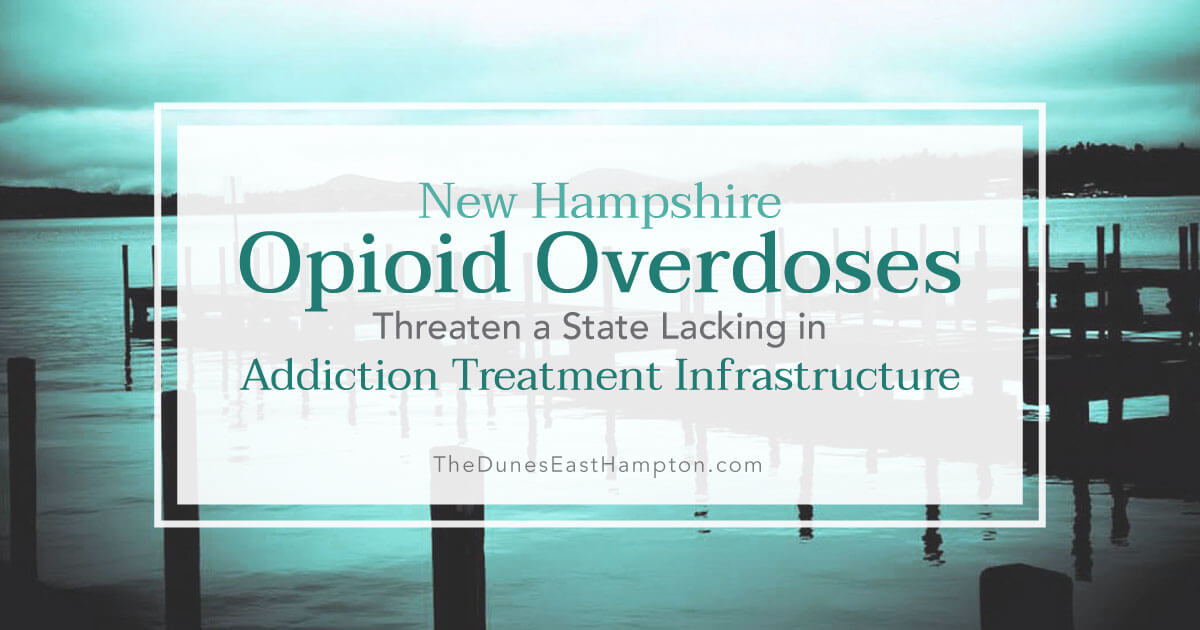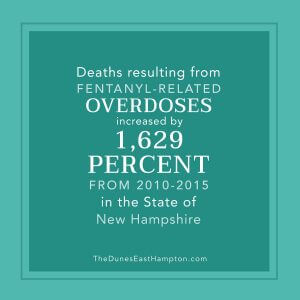
People are dying. If the scourge hasn’t touched your family yet, it likely will, in some way. Vast and escalating numbers of overdose deaths related to opioids are occurring, and many people say their prescriptions are what started their behavior to seek out other painkillers.
But when you think of New Hampshire, are opioids what come to mind? Probably not.
New Hampshire inspires visions of lovely rural settings, ripe with unexplored wilderness adventures. Quaint villages and hamlets dotting the land are posed among tranquil seaside and mountainous views, showcasing the rich territory. The New England state boasts wealthy residents and voters that wield power on Election Day.
It may come as an unexpected shock to learn that as opioid overdose death rates rise across the U.S., New Hampshire ranks second in the nation for most opioid-related deaths per capita and first for fentanyl-related deaths.
The United States is in the vise of an opioid epidemic, a disease that leaves its overdosed victims deprived of air and life. And while you might expect to see a greater increase in opioid-related deaths in states that have larger metropolitan areas and lower incomes, the disease of opioid addiction makes no discrimination based on income, race, age or social stature.
In fact, Narcotics Anonymous meetings today are populated by lawyers, accountants, nurses, young adults and teenagers with comfortable middle-class lifestyles.
While the epidemic is an indiscriminate nationwide one, the Northeastern states are particularly hard-hit by recent surges of fatal opioid overdoses.
New Hampshire is among those suffering the most with the drug crisis. The catastrophe has state officials grappling to contain the spiraling-out-of-control death rates.
‘Live Free or Die’
An inspirational state motto dating back to the volunteer veterans of the Revolutionary War, “Live Free or Die” conveys the assertive independence of American philosophy. Amid the current crisis, it cries out for freedom from living with opioid addiction.
In metropolises and poverty-level populations across the nation, a high supply of illegal drugs can account for much of the overdose death rates. Dealers often cut heroin with deadly substances like fentanyl and its derivatives.
Although affluent neighborhoods have people who use heroin and other illicit drugs, the preponderance of the opioid addiction starts at the doctor’s office through legitimate prescriptions. Painkillers are alarmingly notorious for creating dependency, addiction and overdose.
Because the opioid crisis does not follow the typical boundaries and trends that past drug crises have followed, it is unusually dangerous. The sudden outbreaks can happen anywhere, unpredictably, with multiple fatalities.
The Granite State has garnered the attention of President Trump. The Washington Post recently obtained a transcript of President Donald Trump’s January 27 phone call with Mexican President Enrique Peña Nieto.
“We have a massive drug problem, where kids are becoming addicted to drugs because the drugs are being sold for less money than candy,” Trump said.
He continued, “I won New Hampshire because New Hampshire is a drug-infested den”.
While some critics are offended by Trump’s outspoken style and candid words, others salute the Trump administration for seeking solutions and creating the Commission on Combating Drug Addiction and Opioid Crisis.
On July 31, the commission issued a report advising that President Trump should declare a national emergency because of the influx of opioid-related deaths and addiction.
“American lives are at stake and it threatens our national security,” the report said, referencing the deadly nature of opioids.
New Hampshire Compared to Other States
U.S. News and World Report ranks New Hampshire as the second-best overall state in the country, yet one of the states with the highest rates of opioid-related deaths.
U.S. News and World Report also details the following disconcerting facts:
- The ever-growing economic toll of drug and alcohol abuse on the state of New Hampshire has increased to more than $2.3 billion per year.
- Nearly 500 people died from an overdose last year in New Hampshire alone.
- New Hampshire ranks second in percentage of inhabitants over the age of 12 with drug and alcohol dependence.
- New Hampshire’s opioid-related emergency room visits spiked by a whopping 70 percent in the first half of 2016.
Potential Impact of the American Health Care Act of 2017
The U.S. House of Representatives recently passed a health care bill that some worry would limit New Hampshire’s ability to fight the opioid crisis. The bill eliminates future funding for the Prevention and Public Health Fund, does not increase funding for Medicaid expansion, and allows individual states to determine whether insurers are required to cover substance abuse and mental health treatment.
In New Hampshire in 2012, roughly 63,000 claims for substance abuse treatment were made. In 2014, the number grew to 390,000.
The health care bill hasn’t been able to pass in the U.S. Senate, though, and it appears dead in the water at this time.
A Deadly Grain of Salt
Illicit drugs infiltrate New Hampshire’s borders through trade routes coming from China and Mexico, countries where many drugs are not regulated as controlled substances. Drugs also seep in from other New England states having similar problems.
In fact, up until March of 2017, China had no law against manufacturing or selling the opioid carfentanil, and it was actively marketed and sold over the internet by several Chinese chemical companies.
Carfentanil, an analog of fentanyl, can kill someone in a dose as small as a grain of salt. Consequently, first responders must take precautions to avoid even a granule landing on their skin or being inhaled via nostril.
Carfentanil is 100 times stronger than fentanyl, which is 100 times stronger than morphine. The only viable use for carfentanil is to tranquilize large animals like elephants, and it is banned for human use or warfare as a deadly chemical weapon of mass destruction.
However, carfentanil is impacting lives in New Hampshire. Most people using fentanyl had their first introduction to an opioid through a doctor’s office or hospital, not on a street corner. The tolerance to a prescription created a need for a stronger drug.
And fentanyl has become so popular in New Hampshire that people are reportedly producing it in their kitchen blenders. Apparently, there is a certain group of the population who purposely search out the more potent opioids cut with fentanyl and carfentanil, regardless of the risk of death.
The New Hampshire attorney general reports the drug death toll increasing substantially each year is due to opioid use. The office says it is currently investigating more than three dozen cases involving carfentanil, and at least 10 deaths have been confirmed as carfentanil-related this year.
Terrifying Statistics
The Centers for Disease Control and Prevention (CDC) examined drug overdose deaths by state in studies spanning from 1999 to 2015. The CDC reports drug overdose death rates increasing substantially in recent years.
The CDC’s findings include:
- Opioids are the primary culprit in drug overdose deaths.
- The number of opioid overdoses has quadrupled, and in that same period the number of prescription opioids has coincidingly quadrupled.
- An estimated 142 Americans die every day from a drug overdose.
- That compares to enduring a national death toll greater than September 11 on a monthly basis.
America’s Modern Plague
Here are the ghastly national facts:
- In 2015, more than 52,000 Americans died from drug overdoses.
- Almost two-thirds of drug overdose deaths involve prescription or illegal opioids.
- In 2015, 21 million people self-reported a substance abuse disorder.
- Only 10 percent of those who admit to having a substance abuse disorder receive any type of specialized treatment.
- Drug overdose deaths in 2016 jumped to more than 60,000 people.
- The massive opioid death toll is now the leading cause of death among Americans under the age of 50.
- More people are using prescription painkillers than are using tobacco now.
- All evidence points to a continued worsening problem in 2017.
Here are the staggering stats specific to New Hampshire:
- Drug overdose deaths have increased by nearly 200 percent in the past five years.
- Fentanyl-related deaths have skyrocketed by 1,629 percent from 2010 to 2015.
- There was a 128.6 percent increase in the number of all drug overdose deaths in the state between 2013 and 2015.
- Approximately 4 million doses of Schedule II painkillers are dispensed from New Hampshire pharmacies every month.
- New Hampshire ranks in the top two states for opioid overdose death rate and all drug overdose death rate.
- The state ranks No. 3 for “percent change in all drug overdose death rate from prior year.”
- The leading killer is the opioid fentanyl.
This means the overdose death rate in New Hampshire is currently rising substantially and in greater proportion than in almost all other states.
New Hampshire Health Infrastructure
 To further worsen the situation, New Hampshire lags far behind other states in prevention and treatment for opioid abuse.
To further worsen the situation, New Hampshire lags far behind other states in prevention and treatment for opioid abuse.
New Hampshire has never had large-scale problems with drugs before, and had – up until recently – remained virtually untouched by the devastation and crime that accompany substance abuse and addiction.
Because of its history, the state’s health infrastructure is not prepared to deal with the current crisis. Rehabilitation and recovery options, addiction treatment professionals, state diversion and prevention programs are all sorely lacking.
According to the Concord Monitor, “New Hampshire health officials have been working to expand the state’s treatment capacity, which is one of the lowest in the nation”.
One of the lowest treatment capacities plus one of the highest drug death rates equals a desperate need for improvement.
An additional challenge in New Hampshire arises because the state has the second-lowest rate of spending for substance abuse treatment and prevention. There are simply not enough resources available to accommodate residents with addictions.
The grim reality is state coroners’ offices are being overwhelmed.
New Hampshire Lacks Sufficient Addiction Treatment Programs
Politicians – New Hampshire politicians are debating emergency plans and rethinking guidelines regarding how physicians should prescribe opioids.
Government – State officials are scrambling for solutions because not enough treatment facilities even exist in the state to accommodate the needs.
Police – Law enforcement officials in The Granite State are finally recognizing opioid addiction as a disease, not a crime. But change is slow and the state is not equipped to deal with the overflow. So, police departments are compiling lists and lining up addiction specialists and treatment centers out of state.
Laws – Something as simple as a needle-exchange program has been a hard sell for New Hampshire. Unfortunately, HIV rates and Hepatitis C cases have skyrocketed in the U.S. due to intravenous use of heroin and opioids.
Most other states have adopted the policy to allow people using illicit drugs to exchange used needles for clean ones to prevent the spread of disease, decriminalizing the possession of needles containing drug residue. New Hampshire has not previously seen the need to do the same. Only in June of 2017 did the state pass this law — much too late for some. For a state overwhelmed by drug addiction and fatalities, these kinds of laws are overdue.
Life-Saving Overdose Medication Is Scarce
Of noteworthy importance, people are having difficulty accessing Narcan — the life-saving emergency antidote to opioid overdose.
With opioid overdoses now an important public health concern for all walks of life, states use Narcan-distribution programs to provide overdose prevention and recognition training as well as a dose of Narcan for citizens to take home.
But in New Hampshire, even emergency responders don’t have access to enough Narcan to administer in overdose situations. It is a serious issue since firefighters and EMS workers need to carry it with them at all times to accommodate the frenzy of overdoses.
This lack of accessibility means that those suffering an overdose are not likely to get the emergency antidotal medicine in time to save their lives.
Considering the overdose death rates are among the highest in the country, it is a scary place to be. This massive loss of American lives is avoidable with the proper treatment from a qualified facility, such as The Dunes East Hampton.
Where Can New Hampshirites Turn?
People who are addicted to opioids in New Hampshire are in unusually difficult circumstances, even those actively seeking help. The state cannot meet the rising demands fast enough, and families and individuals struggling with a substance use disorder may be left feeling there is nowhere to turn within the state.
The family members and loved ones of people with opioid addiction hurt and share the pain of the overdose victim. A family member or friend is often the one who finds their loved one unconscious or barely conscious due to an overdose. It is a very traumatic event to have to administer CPR to resuscitate your child, spouse or loved one.
New Hampshire residents must look at options out of state for treatment and rehabilitation. When your life or that of your loved one is at risk, you are facing dangerous odds every minute you delay treatment.
In the nearby state of New York, The Dunes East Hampton offers a luxurious haven of safety and comfort for men and women recovering from opioid addiction. There is hope in healing, but urgent action is needed immediately to save lives. If you or someone you know is struggling in New Hampshire, speak with us before it’s too late. Everyone deserves to live free of addiction.







